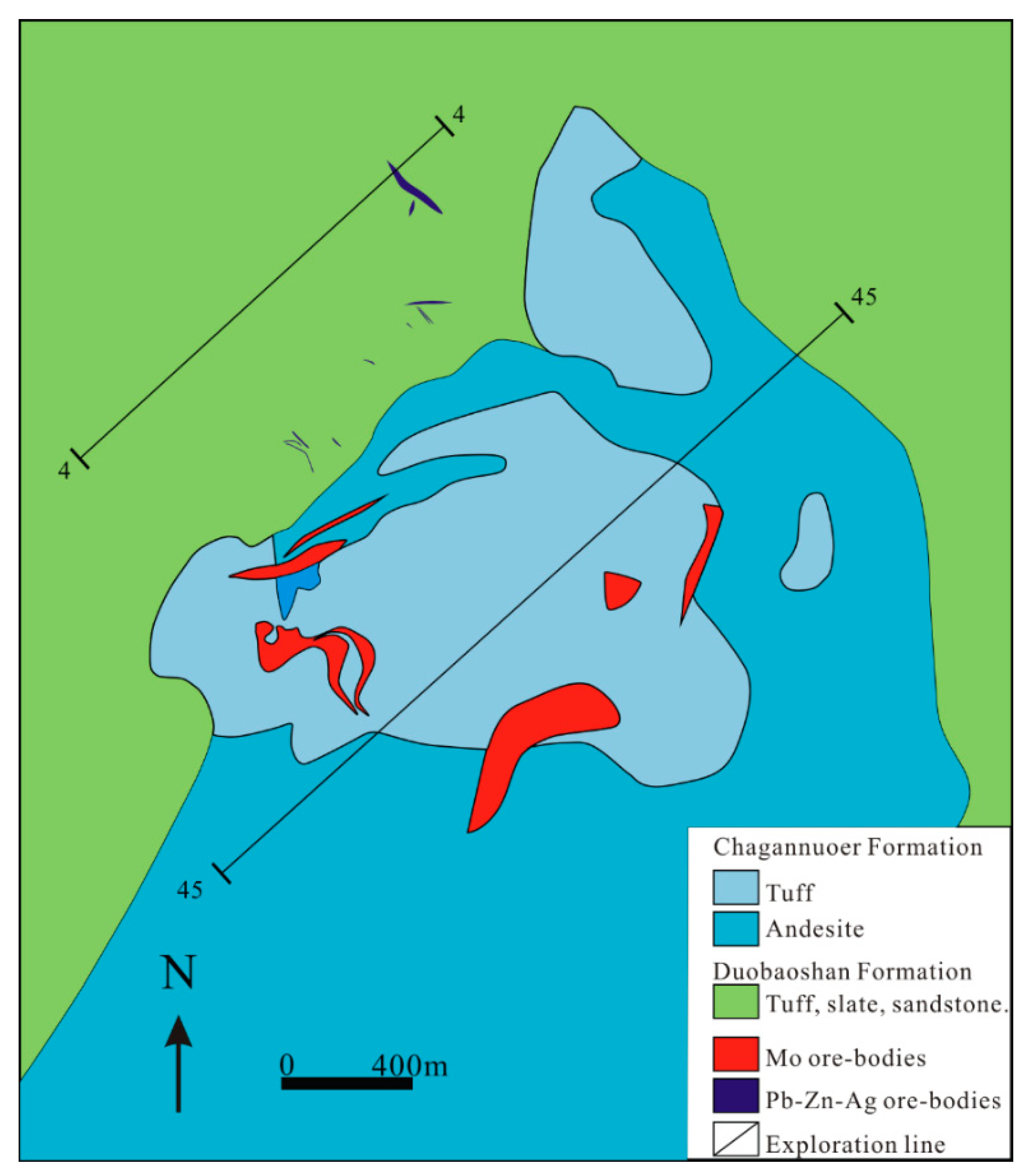Sulfide S and Pb Isotopic Constraint on the Genesis of Diyanqinamu Mo-Pb-Zn Polymetallic Deposit, Inner Mongolia, China
Abstract
1. Introduction
2. Regional Geology
3. Ore Deposit Geology
3.1. Mo Sulfide Deposit
3.2. Pb-Zn Sulfide Deposit
4. Analytical Methods and Samples
5. Results
6. Discussion
6.1. Possible Source of Sulfur
6.2. Origin of Ore-forming Metals
6.3. Genesis of Diyanqinamu Mo-Pb-Zn Polymetallic Deposit
7. Conclusions
Author Contributions
Funding
Acknowledgments
Conflicts of Interest
References
- Zhang, K.; Jin, R.S.; Sun, F.Y.; Li, B.; He, P.; Zhang, Y.L.; Guo, S.; Zhang, T.F. Metallogenesis and ore-forming time of the Changtuxili Mn–Ag–Pb–Zn deposit in Inner Mongolia: Evidence from C–O–S isotopes and U–Pb geochronology. Geosci. Front. 2019, 11, 13. [Google Scholar] [CrossRef]
- Sun, H.R.; Yan, G.S.; Lv, Z.C.; Yu, X.F.; Li, Y.S.; Gong, F.Y. Analysis of the spatial and temporal distribution and metallogical background of molybdenum deposits in Northeast China. China Min. Mag. 2016, S1, 189–196, (in Chinese with English abstract). [Google Scholar]
- Liu, J.M.; Zhang, R.; Zhang, Q.Z. The regional metallogeny of Da Hinggan ling, China. Earth Sci. Front. 2004, 11, 269–277, (in Chinese with English abstract). [Google Scholar]
- Wang, J.B.; Wang, Y.W.; Wang, L.J. Copper metalogenic setting and prospecting potential in the middle southern part of Da Hinggan Moutains. Geol. Prospect. 2000, 36, 1–4, (in Chinese with English abstract). [Google Scholar]
- Zeng, Q.D.; Liu, J.M.; Chu, S.X.; Guo, Y.P.; Guo, S.; Guo, L.X.; Zhai, Y.Y. Poly-Metal Mineralization and Exploration Potential in Southern Segment of the Da Hinggan Mountains. J. Jilin Univ. Earth Sci. Ed. 2016, 46, 1100–1123, (in Chinese with English abstract). [Google Scholar]
- Bai, L.A.; Sun, J.G.; Gu, A.L.; Zhao, K.Q.; Sun, Q.L. A review of the genesis, geochronology, and geological significance of hydrothermal copper and associated metals deposits in the Great Xing’an Range, NE China. Ore Geol. Rev. 2014, 61, 192–203. [Google Scholar] [CrossRef]
- Ouyang, H.; Mao, J.W.; Hu, R.Z. Geochemistry and Crystallization Conditions of Magmas Related to Porphyry Mo Mineralization in Northeastern China. Econ. Geol. 2020, 115, 79–100. [Google Scholar] [CrossRef]
- Zhou, Z.H.; Gao, X.; Ouyang, H.G.; Liu, J.; Zhao, J.Q. Formation mechanism and intrinsic genetic relationship between tin-tungstenlithium mineralization and peripheral lead-zinc-silver-copper mineralization: Exemplified by Weilasituo tin-tungsten-lithium polymetallic deposit, Inner Mongolia. Miner. Depos. 2019, 38, 1004–1022. [Google Scholar]
- Chen, Y.J.; Zhang, C.; Wang, P.; Pirajno, F.; Li, N. The Mo deposits of Northeast China: A powerful indicator of tectonic settings and associated evolutionary trends. Ore Geol. Rev. 2017, 81, 602–640. [Google Scholar] [CrossRef]
- Wang, C.N.; Wang, Q.M.; Yu, X.F.; Han, Z.Z. Metallognetic Characteristics of Tin and Ore-Search Prospect in the Southern Part of Da Hinggan Mountains. Geol. Explor. 2016, 52, 220–227, (in Chinese with English abstract). [Google Scholar]
- Chen, Y.J.; Pirajno, F.; Li, N.; Deng, X.H. Molybdenum deposits in China. Ore Geol. Rev. 2017, 81, 401–404. [Google Scholar] [CrossRef]
- Lawley, C.J.M.; Richards, J.P.; Anderson, R.G.; Creaser, R.A.; Heaman, L.M. Geochronology and Geochemistry of the MAX Porphyry Mo Deposit and its Relationship to Pb-Zn-Ag Mineralization, Kootenay Arc, Southeastern British Columbia, Canada. Econ. Geol. 2010, 105, 1113–1142. [Google Scholar] [CrossRef]
- Mao, J.W.; Zhang, J.D.; Pirajno, F.; Ishiyama, D.; Su, H.M.; Guo, C.L.; Chen, Y.C. Porphyry Cu–Au–Mo–epithermal Ag–Pb–Zn–distal hydrothermal Au deposits in the Dexing area, Jiangxi province, East China—A linked ore system. Ore Geol. Rev. 2011, 43, 203–216. [Google Scholar] [CrossRef]
- Jin, C.; Chen, W.T.; Gao, X.Y.; Li, X.C.; Bao, Z.W.; Zhao, T.P. Origin of the Wangpingxigou Pb-Zn deposit in East Qinling orogenic belt, China: Distal response to the giant Donggou porphyry Mo system? Ore Geol. Rev. 2019, 109, 101–116. [Google Scholar] [CrossRef]
- Li, Z.K.; Bi, S.J.; Li, J.W.; Zhang, W.; Cooke, D.R.; Selby, D. Distal Pb-Zn-Ag veins associated with the world-class Donggou porphyry Mo deposit, southern North China craton. Ore Geol. Rev. 2017, 82, 232–251. [Google Scholar] [CrossRef]
- Mao, J.W.; Ye, H.S.; Wang, T.Y.; Dai, J.Z.; Jian, W.; Xiang, J.F.; Zhou, K.; Meng, F. Mineral deposit model of Mesozoic porphyry Mo and vein-type Pb-Zn-Ag ore deposits in the eastern Qinling, Central China and its implication for prospecting. Geol. Bull. China 2009, 28, 72–79, (in Chinese with English abstract). [Google Scholar]
- Sillitoe, R.H. Porphyry Copper Systems. Econ. Geol. 2010, 105, 3–41. [Google Scholar] [CrossRef]
- Xie, Y.L.; Wang, C.; Ji, Y.G.; Li, L.M.; Li, Y.X.; Tang, Y.W. Porphyry Mo (W)-Epithermal Pb-Zn (Ag) metallogenic system inDongwuqi area, Inner Mongolia. Acta Mineral. Sin. 2015, S1, 81. (in Chinese). [Google Scholar]
- Yang, M.Z.; Hou, K.; Lu, J.P.; Jiang, F.; Fu, J.J. Chronology of Molybdenum-Lead-Zinc Polymetallic Deposit of Suo Naga, Dong Ujimqin Banner Region. Earth Sci. J. China Univ. Geosci. 2012; 37, 1327–1337, (in Chinese with English abstract). [Google Scholar]
- Yu, Y.A.; Liu, H.L.; Li, J.M.; Ma, X.; Chao, Y.Y.; Li, Y.W.; Yang, W.G. Discovery and Enlightenment of the Large-Scale Polymetallic Mineralization Belt in Ajile, Inner Mongolia. Gelogly Prospect. 2010, 46, 798–804, (in Chinese with English abstract). [Google Scholar]
- Tian, J.X. Ore-controlling structure in Dasaituo Pb-Zn camp, Dong Ujimqin Banner. Contrib. Geol. Miner. Resour. Res. 2005, 20, 102–105, (in Chinese with English abstract). [Google Scholar]
- Jia, L.Q.; Wang, Z.H.; Xu, W.Y.; Wang, L.; Li, H.; Chang, C.J. Geological and Geochemical Characteristics and Genesis of Silver-Lead-Zinc Deposit at 1017 Highland in Dong Ujimqin Banner, Inner Mongolia. Geol. Explor. 2014, 50, 550–563, (in Chinese with English abstract). [Google Scholar]
- Sun, H.R.; Huang, Z.L.; Li, W.B.; Ye, L.; Zhou, J.X. Geochronological, isotopic and mineral geochemical constraints on the genesis of the Diyanqinamu Mo deposit, Inner Mongolia, China. Ore Geol. Rev. 2015, 65, 70–83. [Google Scholar] [CrossRef]
- Leng, C.B.; Zhang, X.C.; Huang, Z.L.; Huang, Q.Y.; Wang, S.X.; Ma, D.Y.; Luo, T.Y.; Li, C.; Li, W.B. Geology, Re-Os ages, sulfur and lead isotopes of the Diyanqinamu porphyry Mo deposit, Inner Mongolia, NE China. Econ. Geol. 2015, 110, 557–574. [Google Scholar] [CrossRef]
- Ohmoto, H.; Goldhaber, M.B. Sulfur and Carbon Isotopes. In Geochemistry of Hydrothermal Ore Deposits, 3rd ed.; Barnes, H.L., Ed.; Wiley: New York, NY, USA, 1997. [Google Scholar]
- Zhou, J.X.; Huang, Z.L.; Zhou, M.F.; Li, X.B.; Jin, Z.G. Constraints of C–O–S–Pb isotope compositions and Rb–Sr isotopic age on the origin of the Tianqiao carbonate-hosted Pb–Zn deposit, SW China. Ore Geol. Rev. 2013, 53, 77–92. [Google Scholar] [CrossRef]
- Carr, G.R.; Dean, J.A.; Suppel, D.W.; Heithersay, P.S. Precise lead isotope fingerprinting of hydrothermal activity associated with Ordovician to carboniferous metallogenic events in the Lachlan fold belt of New South Wales. Econ. Geol. Bull. Soc. 1995, 90, 1467–1505. [Google Scholar] [CrossRef]
- Zhou, C.X.; Wei, C.S.; Guo, J.Y.; Li, C.Y. The source of metals in the Qilinchang Zn-Pb deposit, northeastern Yunnan, China: Pb-Sr isotope constraints. Econ. Geol. Bull. Soc. 2001, 96, 583–598. [Google Scholar] [CrossRef]
- Tian, J.X.; Ren, Z.L.; Song, Z.Y.; Huang, S.Q.; Li, S.Z.; Zhang, H.; Xie, Y.J.; Zhang, Y.F. Report on Geological Survey of Diyanqinamu Molybdenum-Silver Polymetallic Deposit in Dong, Ujimqin Banner, Inner Mongolia; The First Geological Exploration Institute of General Administration of Metallurgical Geology of China: Sanhe City, China, 2012; Unpublished work; (in Chinese. [Google Scholar]
- Yan, H.; Huang, F.X.; Sun, H.; Zhao, L.Q.; Zhang, Y.; Zhang, H.; Li, S.Z.; Liu, F.F.; Wang, J.S. A Model for Alteration Zoning of Hydrothermal Mineralization Based on Surpae Software for the Diyanqinamu Mo Mine District, Inner Mongolia. Geol. Prospect. 2012, 48, 932–939, (in Chinese with English abstract). [Google Scholar]
- Shao, J.A.; Zhang, Q.; Mu, B.L. Distribution of Uranium and Molybdenum Deposits and Their Relations with Medium Massifs in Central Asian Orogenic Zone. J. Jilin Univ. Earth Sci. Ed. 2011, 41, 1667–1675, (in Chinese with English abstract). [Google Scholar]
- Sun, H.R.; Huang, Z.L.; Li, W.B.; Leng, C.B.; Ma, D.Y.; Zhang, X.C. Chronology, geochemistry and Sr-Nd isotope studies of Jurassic intrusions in the Diyanqinamu porphyry Mo mine, central Inner Mongolia, China. J. Asian Earth Sci. 2014, 88, 85–97. [Google Scholar] [CrossRef]
- Wu, F.Y.; Sun, D.Y.; Ge, W.C.; Zhang, Y.B.; Grant, M.L.; Wilde, S.A.; Jahn, B.M. Geochronology of the Phanerozoic granitoids in northeastern China. J. Asian Earth Sci. 2011, 41, 1–30. [Google Scholar] [CrossRef]
- Jahn, B.M.; Capdevila, R.; Liu, D.Y.; Vernon, A.; Badarch, G. Sources of Phanerozoic granitoids in the transect Bayanhongor–Ulaan Baatar, Mongolia: Geochemical and Nd isotopic evidence, and implications for Phanerozoic crustal growth. J. Asian Earth Sci. 2004, 23, 629–653. [Google Scholar] [CrossRef]
- Chen, Y.J.; Chen, H.Y.; Zaw, K.; Pirajno, F.; Zhang, Z.J. Geodynamic settings and tectonic model of skarn gold deposits in China: An overview. Ore Geol. Rev. 2007, 31, 139–169. [Google Scholar] [CrossRef]
- Meng, Q.R. What drove late Mesozoic extension of the northern China-Mongolia tract? Tectonophysics 2003, 369, 20. [Google Scholar] [CrossRef]
- Xu, W.L.; Pei, F.P.; Wang, F.; Meng, E.; Ji, W.Q.; Yang, D.B.; Wang, W. Spatial-temporal relationships of Mesozoic volcanic rocks in NE China: Constraints on tectonic overprinting and transformations between multiple tectonic regimes. J. Asian Earth Sci. 2013, 74, 167–193. [Google Scholar] [CrossRef]
- Ying, J.F.; Zhou, X.H.; Zhang, L.C.; Wang, F. Geochronological framework of Mesozoic volcanic rocks in the Great Xing’an Range, NE China, and their geodynamic implications. J. Asian Earth Sci. 2010, 39, 786–793. [Google Scholar] [CrossRef]
- Zhang, J.H.; Gao, S.; Ge, W.C.; Wu, F.Y.; Yang, J.H.; Wilde, S.A.; Li, M. Geochronology of the Mesozoic volcanic rocks in the Great Xing’an Range, northeastern China: Implications for subduction-induced delamination. Chem. Geol. 2010, 276, 144–165. [Google Scholar] [CrossRef]
- Zhang, F.Q.; Chen, H.L.; Yu, X.; Dong, C.W.; Yang, S.F.; Pang, Y.M.; Batt, G.E. Early Cretaceous volcanism in the northern Songliao Basin, NE China, and its geodynamic implication. Gondwana Res. 2011, 19, 163–176. [Google Scholar] [CrossRef]
- Mao, J.W.; Xie, G.Q.; Zhang, Z.H.; Li, X.F.; Wang, Y.T.; Zhang, C.Q.; Li, Y.F. Mesozoic large-scale metallogenic pulses in North China and corresponding geodynamic settings. Acta Pet. Sin. 2005, 21, 169–188, (in Chinese with English abstract). [Google Scholar]
- Hong, D.W.; Wang, S.; Xie, G.L.; Zhang, J.S. Genesis positive ε(Nd,t) grantoids in the Da Hinggan Mts.-Mongolia Orogenic belt and growth continental crust. Earth Sci. Front. 2000, 7, 441–456, (in Chinese with English abstract). [Google Scholar]
- Wu, F.Y.; Sun, D.Y.; Li, H.M.; Jahn, B.M.; Wilde, S. A-type granites in northeastern China: Age and geochemical constraints on their petrogenesis. Chem. Geol. 2002, 187, 143–173. [Google Scholar] [CrossRef]
- Zeng, Q.D.; Liu, J.M.; Yu, C.M.; Ye, J.; Liu, H.T. Metal deposits in the Da Hinggan Mountains, NE China: Styles, characteristics, and exploration potential. Int. Geol. Rev. 2011, 53, 846–878. [Google Scholar] [CrossRef]
- Xue, H.M.; Guo, L.J.; Hou, Z.Q.; Zhou, X.W.; Tong, Y.; Pan, X.F. The Xilingele complex from the eastern part of the Central Asian-Mongolia Orogenic Belt, China: Products of Early Variscan orogeny other than ancient block: Evidence from zircon SHRIMP U-Pb ages. Acta Pet. Sin. 2009, 25, 2001–2010, (in Chinese with English abstract). [Google Scholar]
- Nie, F.J.; Jiang, S.H.; Zhang, Y.; Bai, D.M.; Hu, P.; Zhao, Y.Y.; Zhang, W.Y.; Liu, Y. Metallogenic Studies and Prospecting Orientation in Central and Eastern Segments Along China-Mongolia Border; Geologic Publishing House: Beijing, China, 2007; (in Chinese with English abstract). [Google Scholar]
- Hong, D.W.; Wang, S.G.; Xie, X.L.; Zhang, J.S.; Wang, T. Metallogenic province derived from mantle sources: Nd, Sr, S and Pb isotope evidence from the Central Asian Orogenic Belt. Gondwana Res. 2003, 6, 711–728. [Google Scholar]
- Ge, W.C.; Wu, F.Y.; Zhou, C.Y.; Zhang, J.H. Porphyry Cu-Mo deposits in the eastern Xing’an-Mongolian Orogenic Belt: Mineralization ages and their geodynamic implications. Chin. Sci. Bull. 2007, 52, 3416–3427, (in Chinese with English abstract). [Google Scholar] [CrossRef]
- Zhang, W.Y.; Nie, F.J.; Jiang, S.H.; Liu, Y.; Hu, P.; Xu, D.Q.; Cui, X.M.; Bai, D.M. Magmatic Activity and Metallogeny of Dong Ujimqin Banner, Inner Mongolia; Geological Publishing House: Beijing, China, 2009; (in Chinese with English abstract). [Google Scholar]
- Sun, H.R.; Huang, Z.L.; Yan, Z.F.; Yan, G.S.; Lv, Z.C. Geochemical Characteristics and Geological Significance of 260 Ma Basalt from Inner Mongolia, China. Acta Mineral. Sin. 2015, 35, 529–539. [Google Scholar]
- Nie, F.J.; Hu, P.; Jiang, S.H.; Liu, Y.F. Geological Features, Geochronology and Origin of the Tungsten and Tungsten(Molybdenum)Deposits in the Shamai-Yuguzer Mineralization Concentrated Camp along the Sino-Mongolian Border. Acta Geosci. Sin. 2010, 31, 383–394, (in Chinese with English abstract). [Google Scholar]
- Wang, R.; Zhang, Z.C.; Zeng, Q.D.; Wang, Y.B.; Guo, Q.; Chu, H.Y.; Guo, Y.P.; Guo, L.X. The characteristics of ore-forming Fluids and ore-forming mechanism of the Diyanqinamu super-large molybdenum deposit, Inner Mongolia. Acta Pet. Sin. 2018, 34, 3582–3596, (in Chinese with English abstract). [Google Scholar]
- Barton, P.B., Jr.; Bethke, P.M. Chalcopyrite disease in sphalerite: Pathology and epidemiology. Am. Miner. 1987, 72, 451–467. [Google Scholar]
- Belshaw, N.S.; Freedman, P.A.; O’Nions, R.K.; Frank, M.; Guo, Y. A new variable dispersion double-focusing plasma mass spectrometer with performance illustrated for Pb isotopes. Int. J. Mass Spectrom. 1998, 181, 51–58. [Google Scholar] [CrossRef]
- Ohmoto, H. Systematics of Sulfur and Carbon Isotopes in Hydrothermal Ore Deposits. Econ. Geol. 1972, 67, 551–578. [Google Scholar] [CrossRef]
- Zartman, R.E.; Doe, B.R. Plumbotectonics—The Model. Tectonophysics 1981, 75, 135–162. [Google Scholar] [CrossRef]
- Dixon, G.; Davidson, G.J. Stable isotope evidence for thermochemical sulfate reduction in the Dugald river (Australia) strata-bound shale-hosted zinc-lead deposit. Chem. Geol. 1996, 129, 227–246. [Google Scholar] [CrossRef]
- Ohmoto, H.; Kaiser, C.J.; Geer, K.A. Systematics of Sulphur Isotopes in Recent Marine Sediments and Ancient Sediment-Hosted Base Metal Deposits. In Stable Isotopes and Fluid Processes in Mineralization 23; Herbert, H.K., Ho, S.E., Eds.; University of Western Australia: Crawley, Australia, 1990. [Google Scholar]
- Baoyin, W.L.J.; Liu, H.M.; Zhao, Z.Y.; He, H.Y.; Hao, X.L.; Wang, Z.Y. Geologic chracteristics and prospecting potentiality of the Pb-Zn polymetal deposits in Huahalejin area, Inner Mongolia. Geol. Resour. 2012, 21, 432–436, (in Chinese with English abstract). [Google Scholar]
- Sillitoe, R.H. The tops and bottoms of porphyry copper deposits. Econ. Geol. 1973, 68, 799–815. [Google Scholar] [CrossRef]
- Kong, W.Q.; Liu, C.; Deng, J.F.; Xu, L.Q.; Tao, J.X.; Luo, Z.H.; Zhao, G.C. The characteristics of igneous rock and LA-ICP MS zircon dating in Wuhuaaobao Mo deposit, Erlianhot area of Inner Mongolia. Earth Sci. Front. 2012, 19, 123–135, (in Chinese with English abstract). [Google Scholar]
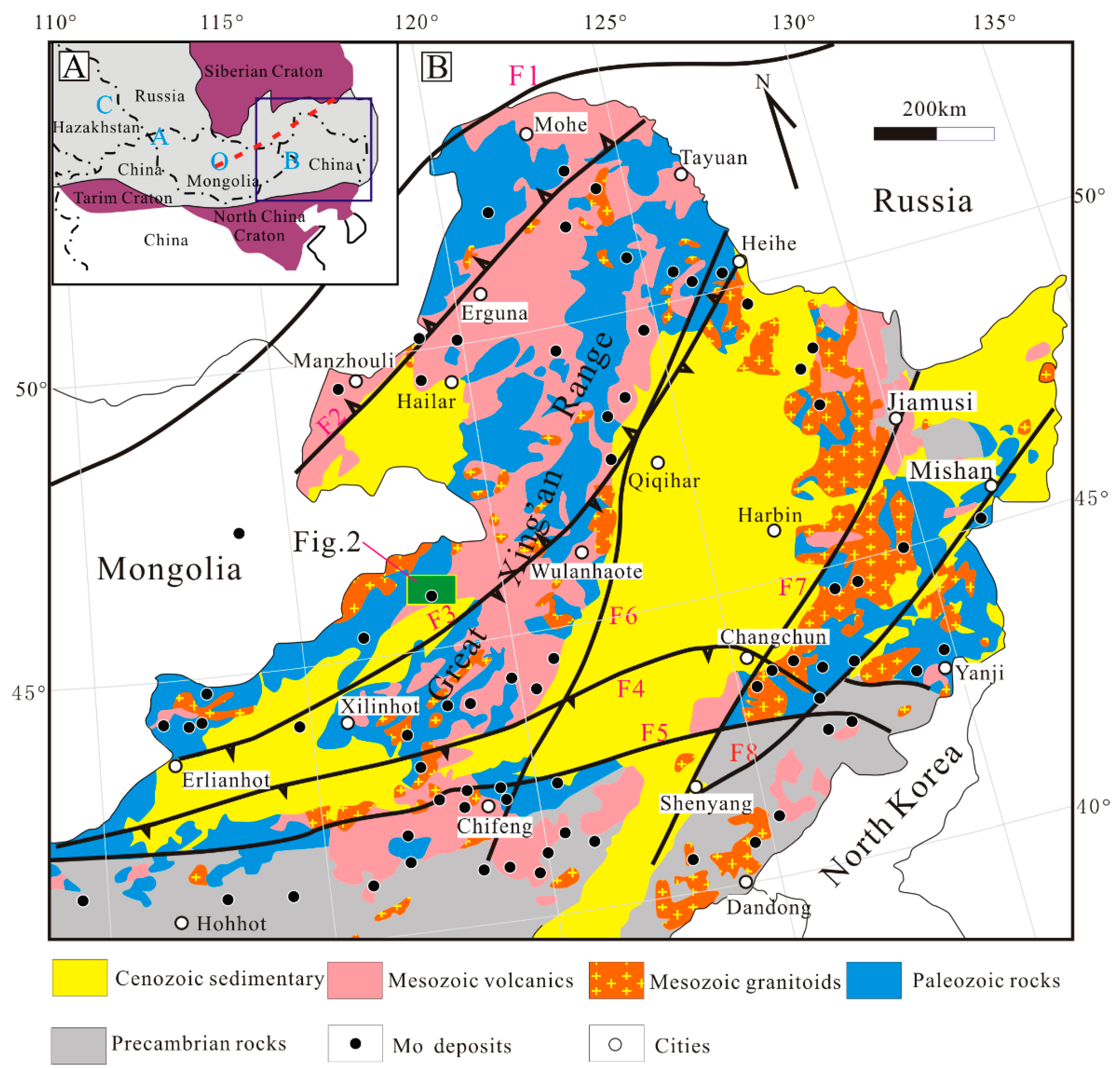
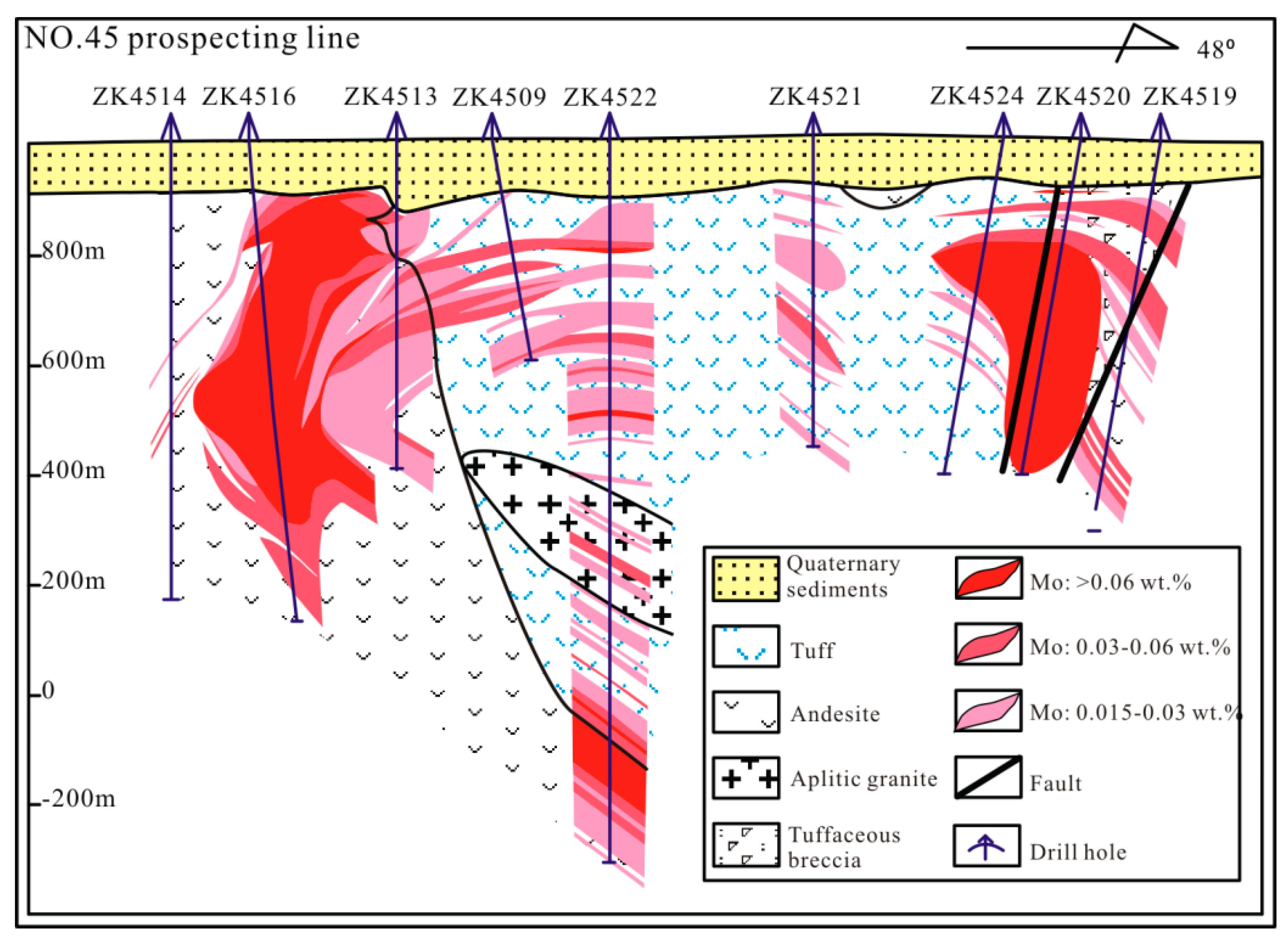
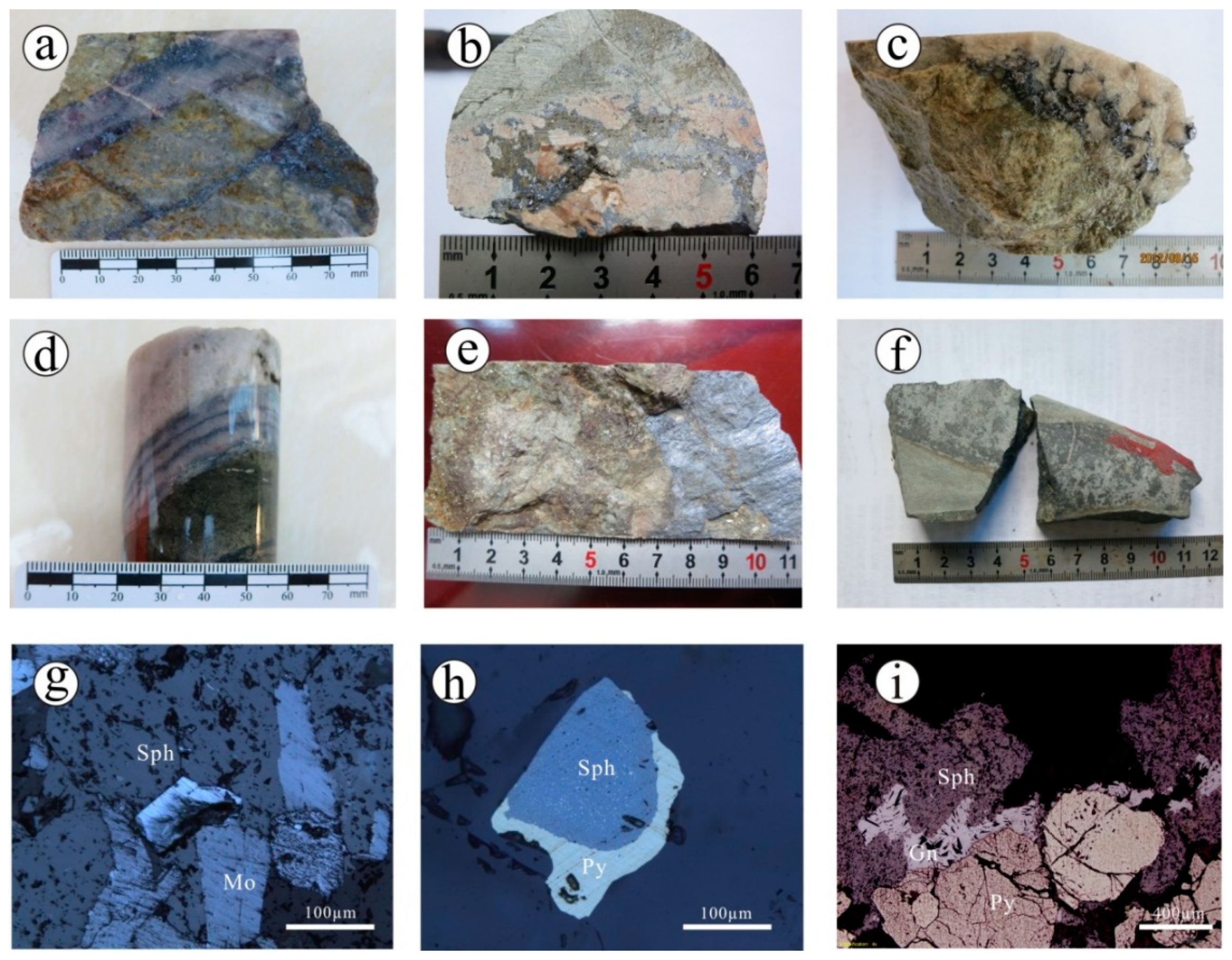
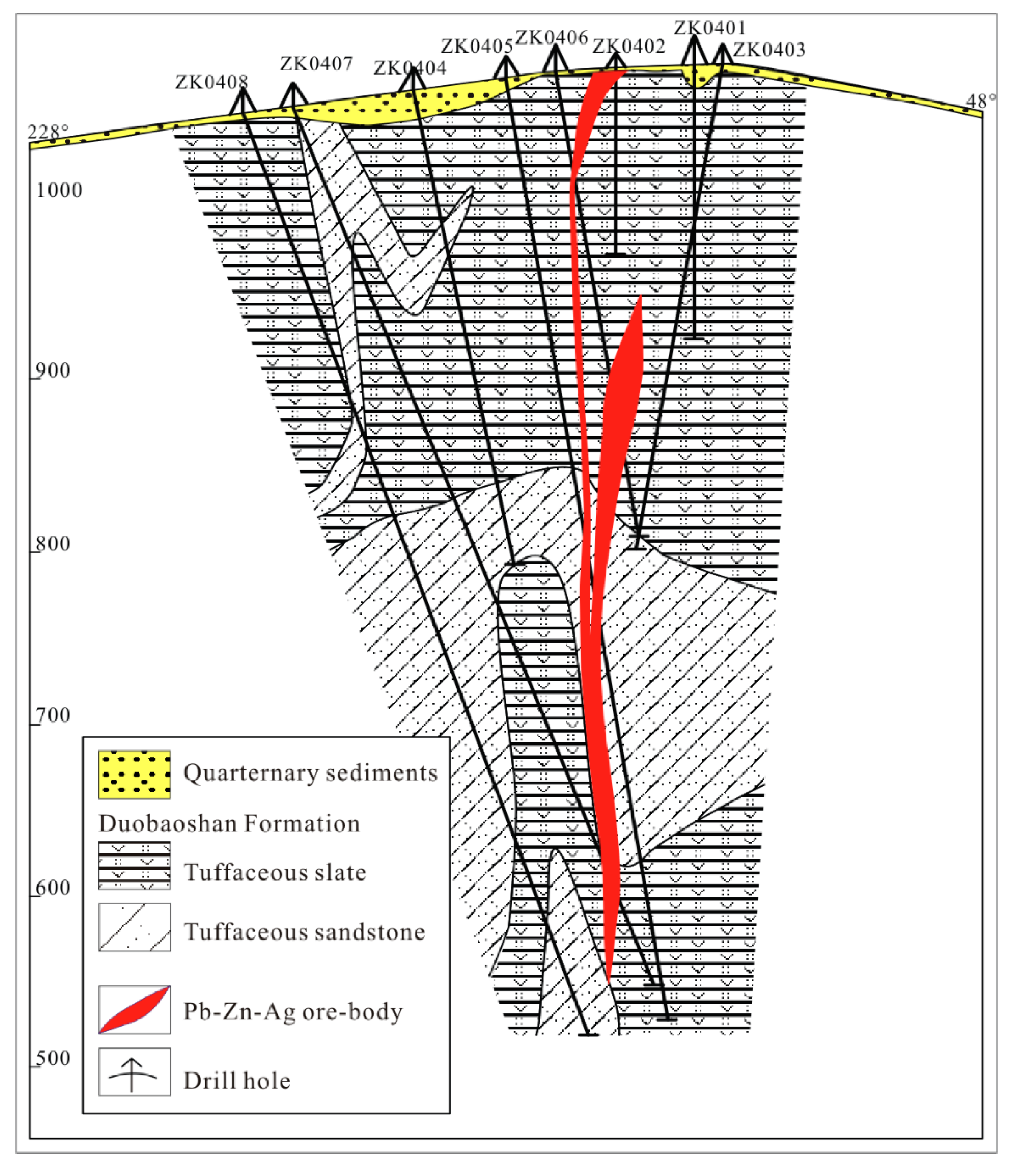
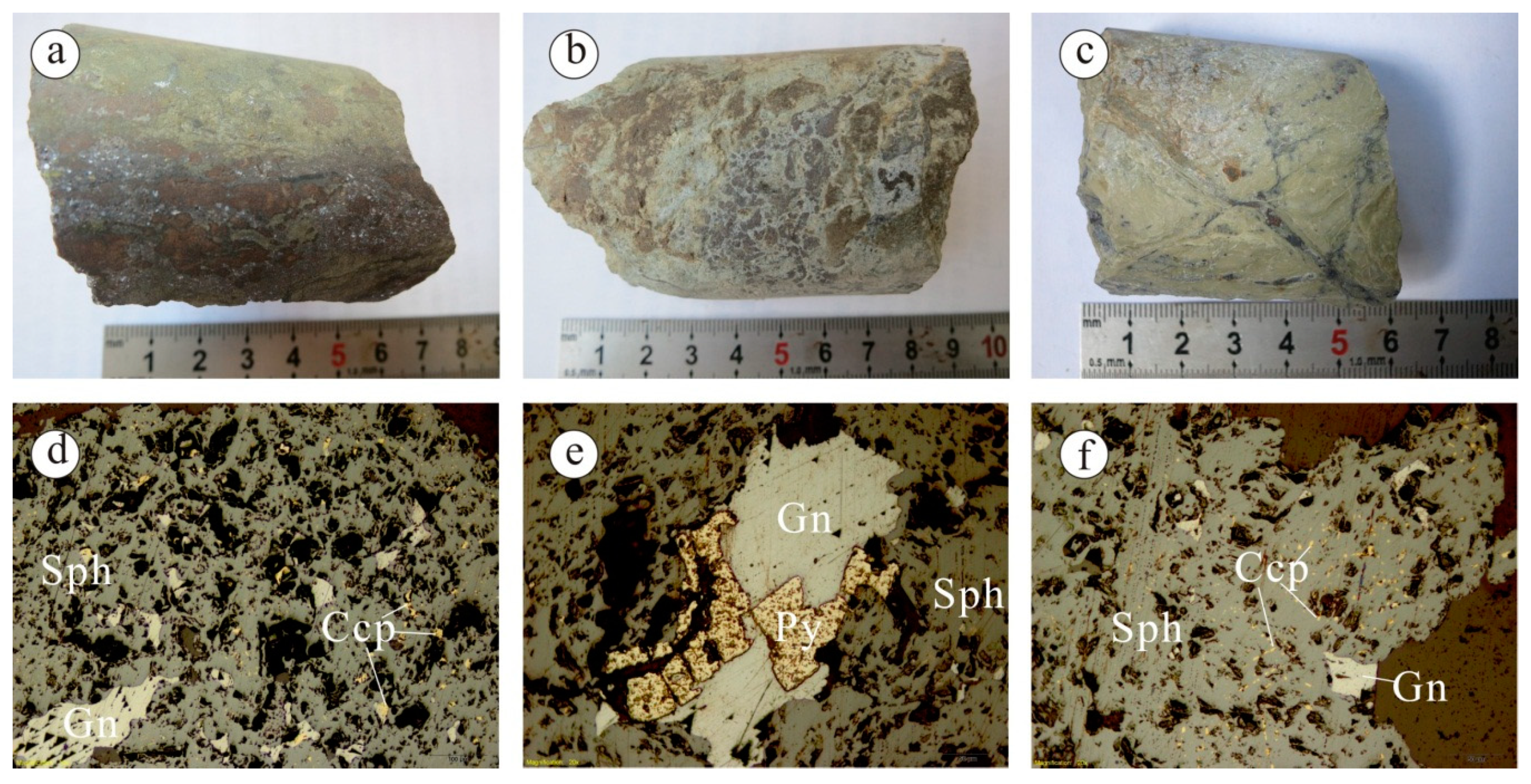
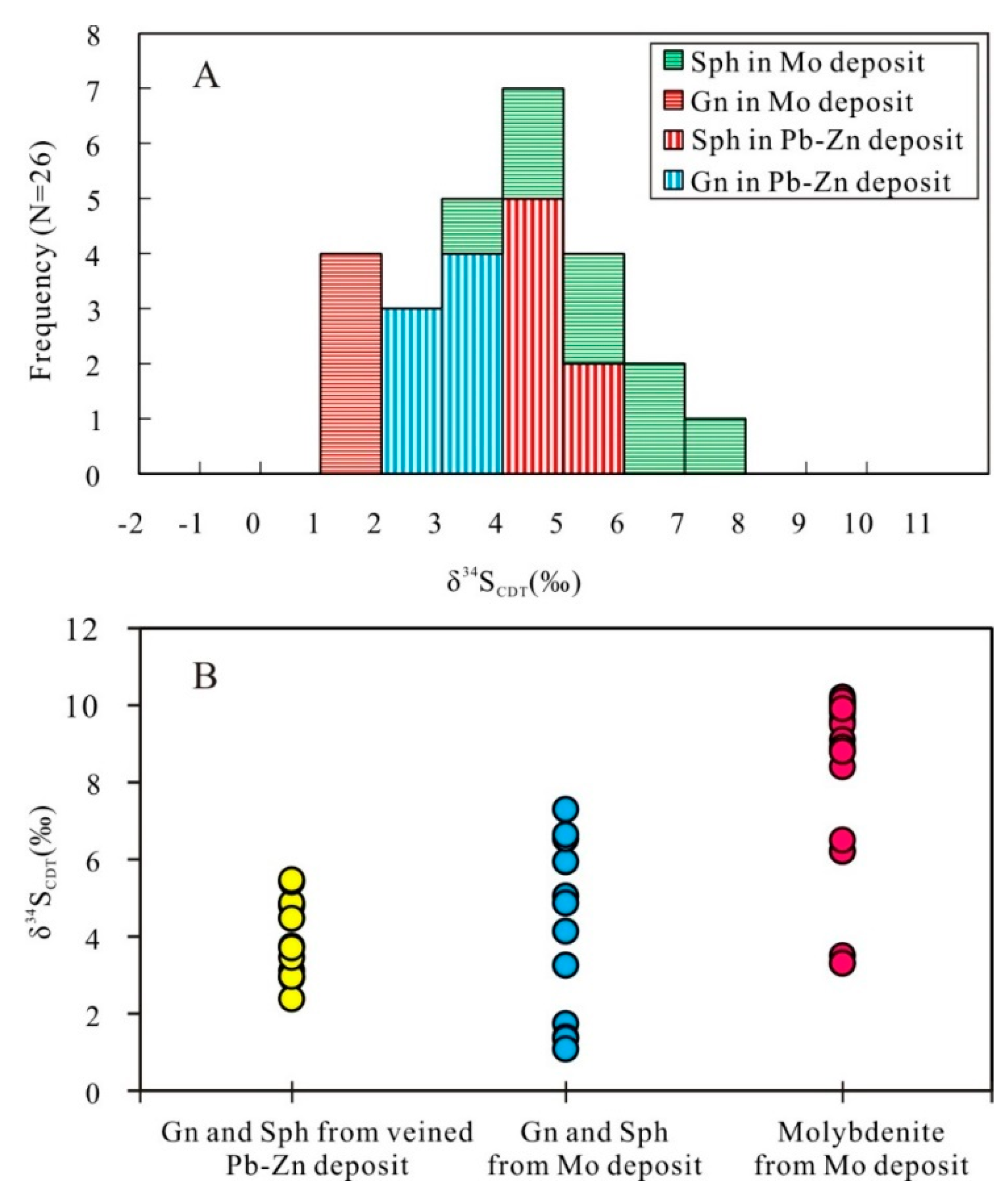
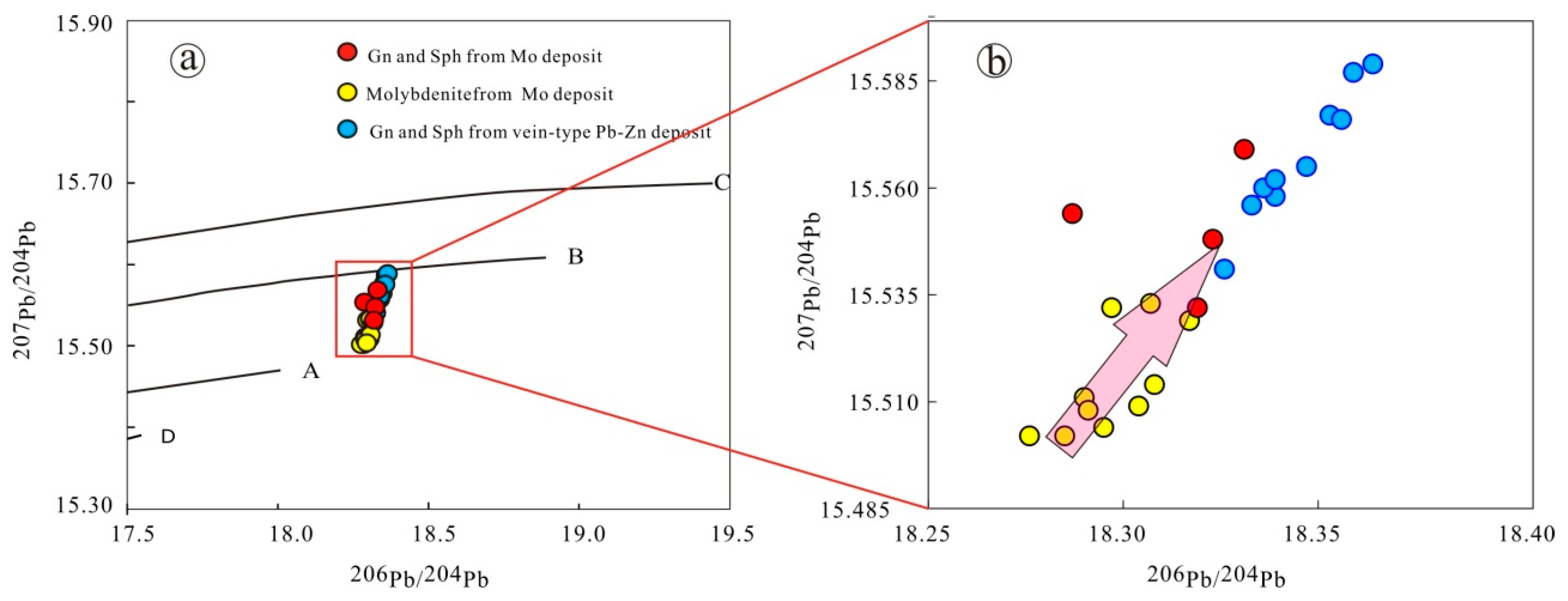
| Sample no. | δ34SV-CDT‰ | T/°C | Sample Location | |
|---|---|---|---|---|
| Sphalerite | Galena | |||
| ZK0643-6 | 4.83 ± 0.03 | 2.92 ± 0.01 | 230 | Pb-Zn deposit |
| ZK0643-7 | 4.79 ± 0.08 | 3.11 ± 0.03 | 245 | |
| ZK0643-8 | 4.47 ± 0.04 | 2.38 ± 0.01 | 220 | |
| ZK0643-9 | 4.87 ± 0.04 | 2.96 ± 0.08 | 230 | |
| ZK0643-13 | 4.46 ± 0.13 | 3.45 ± 0.01 | 315 | |
| ZK0643-15 | 5.41 ± 0.02 | 3.74 ± 0.02 | 246 | |
| ZK0643-16 | 5.46 ± 0.02 | 3.70 ± 0.02 | 239 | |
| ZK5304-33 | 3.25 ± 0.19 | 1.73 ± 0.02 | 258 | Mo deposit |
| ZK3734-6 | 1.39 ± 0.01 | |||
| ZK3734-20 | 1.35 ± 0.01 | |||
| ZK5304-34 | 1.08 ± 0.05 | |||
| ZK5304-14 | 5.94 ± 0.01 | |||
| ZK3734-2 | 7.29 ± 0.05 | |||
| ZK3734-19 | 5.04 ± 0.02 | |||
| ZK6115-10 | 4.13 ± 0.07 | |||
| ZK3314-12 | 6.53 ± 0.02 | |||
| ZK3314-9 | 6.63 ± 0.03 | |||
| ZK4107-3 | 4.86 ± 0.05 | |||
| Sample no. | Mineral | 208Pb/204Pb | Std Err | 207Pb/204Pb | Std Err | 206Pb/204Pb | Std Err | Ore Type |
|---|---|---|---|---|---|---|---|---|
| ZK0643-6 | Gn | 38.054 | 0.003 | 15.541 | 0.001 | 18.326 | 0.001 | Pb-Zn ores |
| ZK0643-14 | 38.114 | 0.004 | 15.558 | 0.003 | 18.339 | 0.003 | ||
| ZK0643-13 | 38.112 | 0.002 | 15.560 | 0.001 | 18.336 | 0.001 | ||
| ZK0643-15 | 38.102 | 0.003 | 15.556 | 0.001 | 18.333 | 0.001 | ||
| ZK0643-16 | 38.201 | 0.004 | 15.587 | 0.002 | 18.359 | 0.002 | ||
| ZK0643-6 | Sph | 38.168 | 0.006 | 15.577 | 0.002 | 18.353 | 0.003 | |
| ZK0643-13 | 38.138 | 0.003 | 15.565 | 0.001 | 18.347 | 0.002 | ||
| ZK0643-14 | 38.214 | 0.005 | 15.589 | 0.002 | 18.364 | 0.002 | ||
| ZK0643-15 | 38.123 | 0.004 | 15.562 | 0.002 | 18.339 | 0.002 | ||
| ZK0643-16 | 38.169 | 0.004 | 15.576 | 0.003 | 18.356 | 0.003 | ||
| ZK3734-6 | Gn | 38.072 | 0.005 | 15.554 | 0.002 | 18.287 | 0.002 | Mo ores |
| ZK5304-34 | 38.080 | 0.003 | 15.548 | 0.001 | 18.323 | 0.001 | ||
| ZK3734-19 | Sph | 38.034 | 0.004 | 15.532 | 0.002 | 18.319 | 0.002 | |
| ZK5304-33 | 38.139 | 0.004 | 15.569 | 0.002 | 18.331 | 0.002 |
© 2020 by the authors. Licensee MDPI, Basel, Switzerland. This article is an open access article distributed under the terms and conditions of the Creative Commons Attribution (CC BY) license (http://creativecommons.org/licenses/by/4.0/).
Share and Cite
Sun, H.; Huang, Z.; Lü, Z.; Yu, X.; Li, Y. Sulfide S and Pb Isotopic Constraint on the Genesis of Diyanqinamu Mo-Pb-Zn Polymetallic Deposit, Inner Mongolia, China. Minerals 2020, 10, 304. https://doi.org/10.3390/min10040304
Sun H, Huang Z, Lü Z, Yu X, Li Y. Sulfide S and Pb Isotopic Constraint on the Genesis of Diyanqinamu Mo-Pb-Zn Polymetallic Deposit, Inner Mongolia, China. Minerals. 2020; 10(4):304. https://doi.org/10.3390/min10040304
Chicago/Turabian StyleSun, Hairui, Zhilong Huang, Zhicheng Lü, Xiaofei Yu, and Yongsheng Li. 2020. "Sulfide S and Pb Isotopic Constraint on the Genesis of Diyanqinamu Mo-Pb-Zn Polymetallic Deposit, Inner Mongolia, China" Minerals 10, no. 4: 304. https://doi.org/10.3390/min10040304
APA StyleSun, H., Huang, Z., Lü, Z., Yu, X., & Li, Y. (2020). Sulfide S and Pb Isotopic Constraint on the Genesis of Diyanqinamu Mo-Pb-Zn Polymetallic Deposit, Inner Mongolia, China. Minerals, 10(4), 304. https://doi.org/10.3390/min10040304



